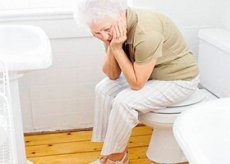Medical expert of the article
New publications
Fecal incontinence
Last reviewed: 04.07.2025

All iLive content is medically reviewed or fact checked to ensure as much factual accuracy as possible.
We have strict sourcing guidelines and only link to reputable media sites, academic research institutions and, whenever possible, medically peer reviewed studies. Note that the numbers in parentheses ([1], [2], etc.) are clickable links to these studies.
If you feel that any of our content is inaccurate, out-of-date, or otherwise questionable, please select it and press Ctrl + Enter.

Fecal incontinence is the loss of control over defecation. This condition is often mistakenly perceived as an inevitable manifestation of old age. Clinically, incontinence is expressed by frequent or constant leakage of semi-formed feces, as well as the passage of formed feces 1-2 times a day in bed or on clothing.
What causes fecal incontinence?
Fecal incontinence may be caused by spinal cord injury or disease, congenital disorders, accidental injury to the rectum and anus, rectal prolapse, diabetes, severe dementia, fecal impaction, extensive inflammatory processes, tumors, obstetric injuries, and surgeries that involve dissection or dilation of the anal sphincter. Fecal incontinence may also be caused by the following processes: use of laxatives, frequent enemas, proctitis, rectal prolapse and cancer, Crohn's disease, inadequate fluid absorption, and ischemic colitis. Fecal incontinence may be caused by a disruption of the nervous system's control over defecation.
How to recognize fecal incontinence?
During physical examination, it is necessary to evaluate the sphincter closure function and perianal sensitivity and exclude fecal impaction. During examination, ultrasound of the anal sphincter, MRI of the pelvis and abdominal cavity, electromyography of the pelvic floor and anorectal manometry are advisable.
What do need to examine?
How to examine?
How is fecal incontinence treated?
Treatment of fecal incontinence involves a bowel preparation program to develop a deliberate urge to defecate. The program includes drinking adequate amounts of fluid and eating large enough meals. Toilet exercises or the use of other commonly used stool stimulants (eg, coffee) stimulate defecation. Suppositories (eg, glycerin, bisacodyl) or phosphate enemas may also be used. If regular stooling is not restored, a low-residue diet and oral loperamide may decrease the frequency of defecation.
Simple perineal exercises, in which the patient repeatedly contracts the sphincter, perineal muscles, and gluteal muscles, can strengthen these structures and contribute to the restoration of sphincter function, especially in mild cases. The principle of biofeedback (training the patient to optimize sphincter function and better perception of physiological stimuli) should be used before recommending surgical treatment in well-motivated patients who understand the meaning of the problem and clearly follow instructions and in whom the anal sphincter retains the ability to perceive irritation during rectal distension. Approximately 70% of such patients respond to biofeedback.
The sphincter defect can be directly sutured. In the absence of conditions for sphincter reconstruction, especially in patients under 50 years of age, a displaced m.gracilis (thin thigh muscle) can be used for plastic surgery. Some centers use a pacemaker m.gracilis and thus form an artificial sphincter; such or similar experimental studies are only being conducted in a few centers in the United States as experimental protocols. Alternatively, a Thiersch wire or other material can be used, which is passed around the anus.
If all methods used prove ineffective, indications for colostomy are given.
How to care for a person with fecal incontinence?
In patient care, prevention of reflex emptying of the large intestine is important. Thus, if the stool occurs after morning tea, then its intake should be combined with sitting on the toilet or a night bowl. High-calorie food in small portions during the day is indicated; the patient is placed on a bedpan, ensuring careful hygiene of the perineum (washing every 2-4 hours, treating the anus with Vaseline or protective cream, timely change of underwear and bed linen); use agents that delay bowel movement, enemas (preferably from a decoction of chamomile), occasionally suppositories. It is necessary to ensure frequent (6-8 times a day) ventilation, if possible, use deodorants.


 [
[